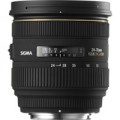DxOMark rating
The result shown by the lens in the DxOMark rating.
DxOMark is one of the most popular and authoritative resources for expert testing of photography devices. According to the test results, the lens receives a certain number of points; The more points, the higher the final score.
Viewing angles
This parameter determines the size of the area of the scene being shot that falls into the frame. The wider the viewing angles, the larger the area the lens can capture in one shot. They are directly related to the focal length of the lens (see "Focal length"), and also depend on the size of the specific matrix with which the optics are used: for the same lens, the smaller the matrix, the smaller the viewing angles, and vice versa. On our website, in the characteristics of optics, viewing angles are usually indicated when used with the matrix for which the lens was originally designed (for more details, see "Matrix Size").
Minimum focus distance
Minimum focus distance (m) - the smallest distance from which you can focus on an object and take a photo. Usually it ranges from 20 cm for wide-angle lenses to several metres for telephoto. In the macro mode of the camera or with the help of macro lenses, this distance can be less than 1 centimeter.
Maximum zoom
The degree of magnification of the object being shot when using a
lens for macro shooting (that is, shooting small objects at the maximum possible approximation, when the distance to the subject is measured in millimetres). The degree of magnification in this case means the ratio of the size of the image of the object obtained on the matrix of the camera to the actual size of the object being shot. For example, with an object size of 15 mm and a magnification factor of 0.3, the image of this object on the matrix will have a size of 15x0.3=4.5 mm. With the same matrix size, the larger the magnification factor, the larger the image size of the object on the matrix, the more pixels fall on this object, respectively, the clearer the resulting image, the more details it can convey and the better the lens is suitable for macro photography. It is believed that in order to obtain macro shots of relatively acceptable quality, the magnification factor should be at least 0.25 – 0.3.
Image stabilization
The presence in the lens of its own
image stabilization system. Such a system includes gyroscopes and movable lenses that compensate for small tremors of the lens and prevent the appearance of “shake”. Stabilization is especially relevant when shooting handheld, especially at slow shutter speeds and/or at long distances with high magnification: it is in such conditions that “shake” affects the quality of the image the most. At the same time, it should be taken into account that the presence of a stabilizer significantly affects the weight, dimensions and, above all, the price of optics; at the same time, some modern cameras have their own stabilization systems (due to matrix shift). Therefore, it makes sense to choose a lens with this function in the case when maximum protection against “shake” is of fundamental importance.
Design (elements/groups)
The number of elements (in fact, the number of lenses) included in the design of the lens, as well as the number of groups in which these elements are combined. Usually, the more elements provided in the design, the better the lens handles with distortions (aberrations) when light passes through it. On the other hand, numerous lenses increases the dimensions and weight of the optics, reduces light transmission (for more details, see "Aperture") and also puts forward increased requirements for the quality of processing, which affects the cost of the lens.
Dustproof & waterproof
Lenses with protection against ingress of dust and moisture. "Protected" optics are useful primarily for those who have to shoot a lot outdoors: they are much more resistant to bad weather than ordinary ones, many of these lenses work quietly in the rain, sea spray, etc. However, the specific degree of protection for different models can significantly differ, this point should be specified separately in the official documentation of the manufacturer. Also note that if you intend to constantly shoot in difficult external conditions, not only the lens, but also the camera itself must have dust and water protection.

